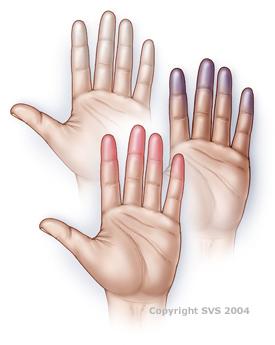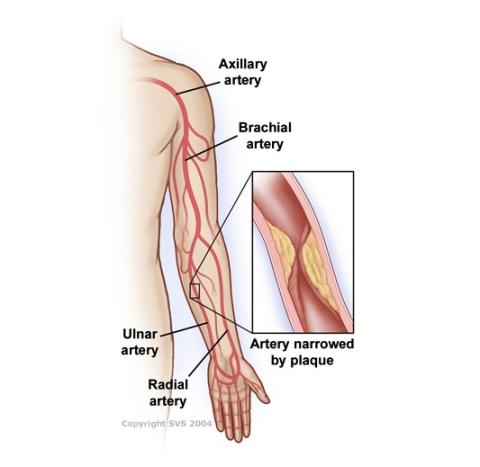Severe Pain and Numbness in the Hands
These symptoms may indicate a fresh blood clot in the arm, which is a medical emergency. Call 911 if you have these symptoms.
Painful or Numb Hands or Fingers
- Coldness and numbness followed by tingling or stinging pain in your fingers may signal Raynaud’s Disease that is linked to a disorder in your arm arteries.
- A dialysis access fistula or graft may take blood away from your hand (steal syndrome), resulting in hand pain or numbness.
Forearm Cramping or Sores That Won’t Heal
These are additional symptoms of arterial disease in the arm.

Arterial disease of the arm can be caused by atherosclerosis, autoimmune diseases, complications from dialysis access or by blood clots that travels from the heart (embolism).
See a Vascular Surgeon
You will be asked questions about symptoms and medical history, including questions about family members. The vascular surgeon will also perform a physical exam that will likely include taking blood pressure readings in your arms and in your fingers.
Tests May Be Recommended
A duplex ultrasound can aid diagnosis. If more information is needed, a CT scan or angiogram may be recommended.
Treatment Depends on the Source of Symptoms
- Atherosclerotic blockages can be treated with angioplasty, stenting or surgical bypass.
- Autoimmune conditions are usually treated with medicines.
- A fresh clot in the arm is treated with lysis (thrombolytic therapy) to break up blood clots, or with open surgery to extract the clots.
- If the lack of blood flow is due to dialysis access, there are a variety of procedures to increase hand blood flow and possibly preserve the fistula or graft.
- Avoiding smoking. If you do smoke, ask your vascular surgeon to help you find a smoking cessation program that will work for you.
- Keep your cholesterol down.
- Maintain a healthy weight.
- If you have a heart arrhythmia like atrial fibrillation, it is important to take blood thinners if prescribed by your doctor.

